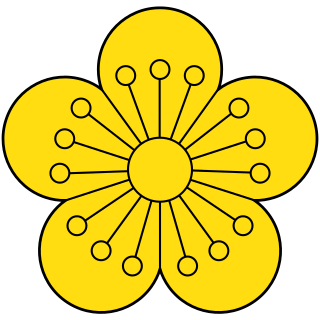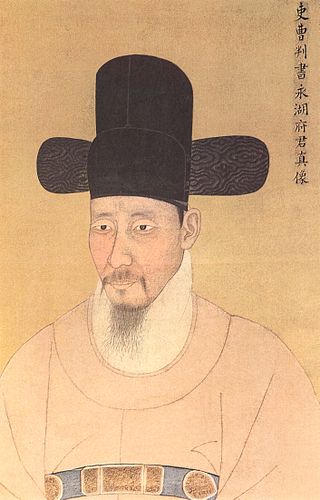Related Research Articles

Taejo of Joseon, personal name Yi Seong-gye, later Yi Dan, was the founder and first ruler of the Joseon dynasty of Korea. After overthrowing the Goryeo dynasty, he ascended to the throne in 1392 and abdicated six years later during a strife between his sons. He was honored as Emperor Go following the establishment of the Korean Empire.

Taejong of Joseon, personal name Yi Bang-won, was the third ruler of the Joseon dynasty of Korea and the father of King Sejong the Great. Before ascending to the throne, he was known as Prince Jeongan.
The Ōei Invasion, also known as the Gihae Expedition, was a 1419 invasion from Joseon against wokou bases on Tsushima Island, which is located in the middle of the Tsushima Strait between the Korean Peninsula and Kyushu.

The House of Yi, also called the Yi dynasty, was the royal family of the Joseon dynasty and later the imperial family of the Korean Empire, descended from the Joseon founder Yi Seong-gye. All of his descendants are members of the Jeonju Yi clan.

Jeongjo of Joseon, personal name Yi San, sometimes called Jeongjo the Great, was the 22nd monarch of the Joseon dynasty of Korea. From 1775 to 1776, he acted as a regent for his grandfather King Yeongjo, and on his death reigned as king from April 27, 1776 until August 18, 1800. On succeeding his grandfather, King Yeongjo, he made various attempts to reform and improve the nation.
The Gyehae Treaty was signed in 1443 between the Joseon dynasty and Sō Sadamori as a means of controlling Japanese piracy and legitimizing trade between Tsushima island and three Korean ports. It is also called Kakitsu Treaty; 1443 is the third year of the Kakitsu era in the Japanese calendar.

Jo Eom was a Korean civil minister (munsin) in the 18th century during the late period of the Korean Joseon Dynasty (1392–1897).
Yi Ye was a nobleman and Korean civil minister and diplomat during the early Joseon Dynasty. He served as an ambassador to the Japanese Ashikaga shogunate and founded the Hakseong Yi clan. He is notable for having negotiated the release of 667 Korean captives from wokou pirates in over 15 diplomatic missions, and for facilitating bi-national cooperation with Japan.
Yun Myeong (?-?) was a scholar-official of the Joseon Dynasty Korea in the 15th century.
Japanese missions to Joseon represent a crucial aspect of the international relations of mutual Joseon-Japan contacts and communication. The bilateral exchanges were intermittent.
Grand Prince Yangnyeong was the former Crown Prince of the Joseon Dynasty of Korea. He was the first son of King Taejong and his wife, Queen Wongyeong. Yangnyeong was the elder brother of Sejong the Great, and an ancestor of Syngman Rhee, an independence activist and the first President of South Korea.

Bak Yeon or Park Yeon was a government official, scholar, writer, astronomer and musician in the Early Joseon Dynasty period, who was a teacher of King Sejong and created Armillary sphere Honcheonui, Water clock Borugak Jagyeongnu and sundial Yangbu Ilgu along with Jang Yeong-sil and five basic sounds(Gung, Sang, Gak, Chi, Wu), which corresponds to five consonant groups in Hunminjeongeum. He has also adapted court music to the new Confucian philosophy, particularly in the concept of yeak, a Confucian ideology that combines ritual and music.
Princess Yeongon was the daughter of King Sunjo of Joseon and Royal Consort Sug-ui of the Miryang Park clan.
Jo In-byeok (1330–1393), was a warrior in the Late Goryeo dynasty who came from the Hanyang Jo clan. He was the husband of Princess Jeonghwa, who was the sister of the founder of the Joseon dynasty, Yi Seonggye, who granted him the title Internal Prince Yongwon when the dynasty was established.
Prince Imhae, was a Joseon Royal Prince as the eldest son of King Seonjo and the elder brother of King Gwanghae. He was known for such a violent and arrogant personality, that he murdered some government officials alongside his half brothers: Prince Jeongwon (정원군) and Prince Sunhwa (순화군), but were survived under their father's protection. Also, when his depravity led to government officials demanding severe punishment for his actions, he was able to avoid such punishment by his father's protection too.
Gim Goeumga or posthumously honoured as Royal Noble Consort Jeong, was the third wife of Yi Jachun.
Lady Yi of the Jeonju Yi clan or posthumously called as Princess Anui, was a Goryeo-born woman who became a part of the early Joseon Royal family member as the only daughter of Yi Haengni and would became the paternal grandaunt of Yi Seonggye, its founder.

The King of Tears, Lee Bang-won is a South Korean television series starring Joo Sang-wook in the title role. With this series, KBS is reviving the historical drama series after 5 years, as the last KBS historical series Jang Yeong-sil was aired in 2016. The series depicts the story of Yi Bang-won, the third king of Joseon, from a new perspective. It premiered on KBS1 December 11, 2021 and aired on Saturdays and Sundays at 21:40 (KST) till May 1, 2022.
The following is a family tree of Korean monarchs.
Yi Yang-mu was a Goryeo general and nephew of Yi Ui-bang, father of Queen Sapyeong. As part of the Jeonju Yi clan, he was the 5th generation ancestor of Yi Seonggye, founder of the Joseon Dynasty.
References
- Daehwan, Noh. "The Eclectic Development of Neo-Confucianism and Statecraft from the 18th to the 19th Century," Korea Journal (Winter 2003).
- Hall, John Whitney. (1997). The Cambridge History of Japan: Early Modern Japan. Cambridge: Cambridge University Press. ISBN 978-0-521-22355-3; OCLC 174552485
- Kang, Etsuko Hae-jin. (1997). Diplomacy and Ideology in Japanese-Korean Relations: from the Fifteenth to the Eighteenth Century. Basingstoke, Hampshire; Macmillan. ISBN 978-0-312-17370-8; OCLC 243874305